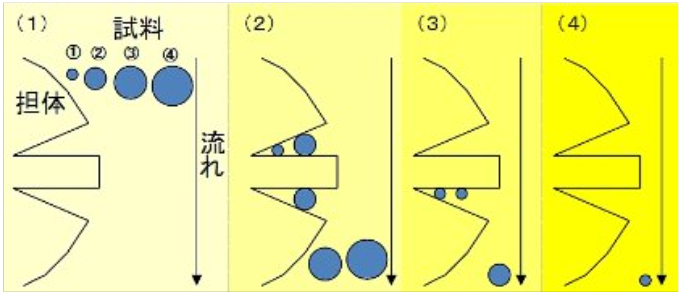Size Exclusion Chromatography Column
1. Size Exclusion Chromatography
When a sample containing components of different sizes is passed through a column filled with a support (gel) having open pores, Component 1, which has the lowest molecular weight among the components in the sample, can penetrate deeply into the pores, as shown in Figure (1).
On the other hand, Component 3, which has a high molecular weight, cannot enter the pores. Component 2, which is of intermediate size, can partially enter the pores. Component 1, which can penetrate deeply into pores, is retained in the column for a longer period. Thus, the order of components eluting from the column is Components 3, 2, and 1. The type of chromatography that separates analytical species according to their size is called size exclusion chromatography (SEC).
2. Exclusion limit molecular weight
If Component 3 has the same diameter as that of the pores and cannot enter the pores as shown in Figure (2), not only Component 3 but also Component 4, which is larger than Component 3, cannot enter the pores. Components 3 and 4 cannot be separated from each other despite their molecular weight difference because they elute from the column simultaneously. The molecular weight of the smallest component that cannot enter the pores (Component 3 in this case) is called the "exclusion limit molecular weight." Components with molecular weights exceeding the exclusion limit molecular weight of the column cannot be separated from each other.
3. Classification of Size Exclusion Chromatography
Size exclusion chromatography is largely classified into applications using organic solvents as eluents and those using aqueous solutions as eluents.
Chromatography using organic solvents is called gel permeation chromatography (GPC), and chromatography using aqueous solutions is called gel filtration chromatography (GFC). Either of these methods is used depending on the sample to be analyzed.
![]()
 Figure 2. principle of Size Exclusion Chromatography
Figure 2. principle of Size Exclusion Chromatography
For research use or further manufacturing use only. Not for use in diagnostic procedures.
Product content may differ from the actual image due to minor specification changes etc.
If the revision of product standards and packaging standards has been made, there is a case where the actual product specifications and images are different.



